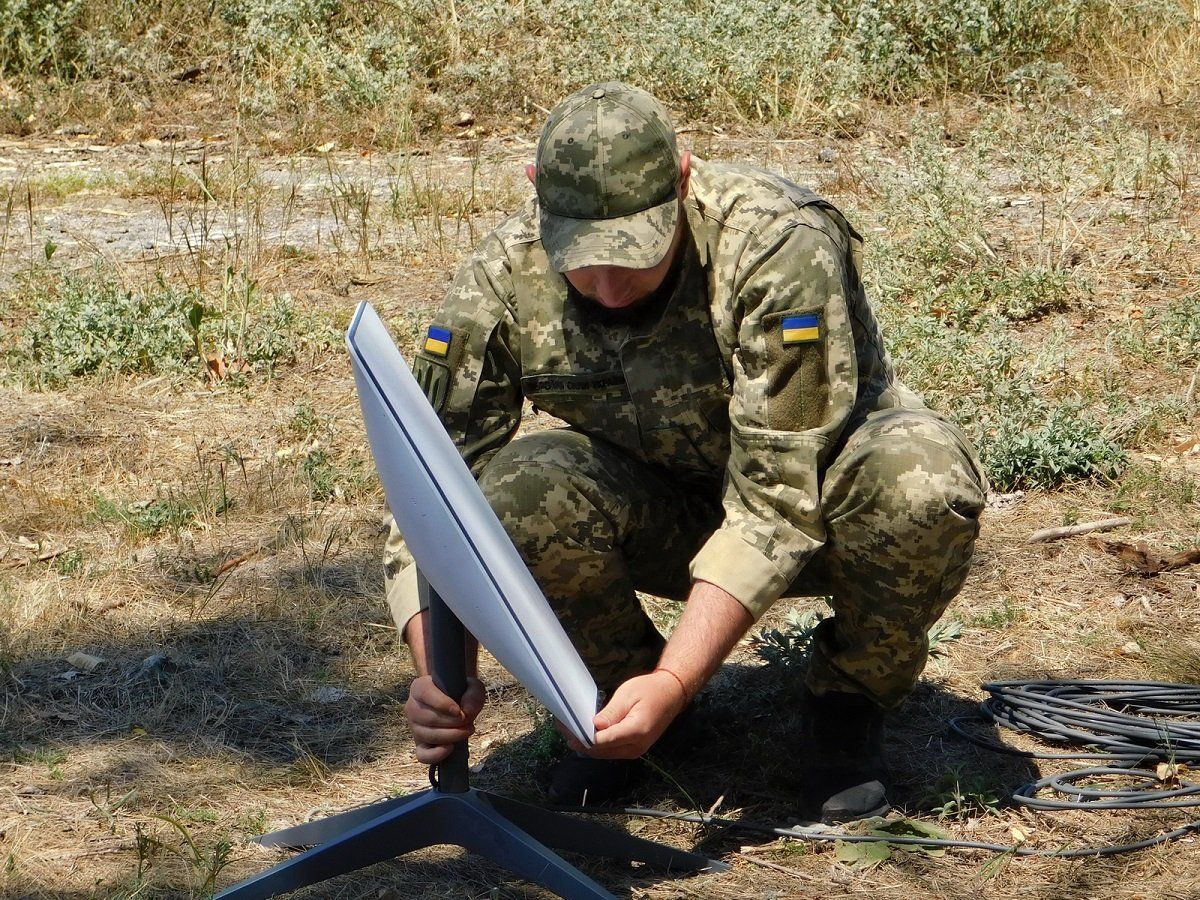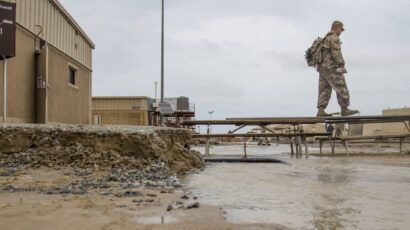As more countries enter space, the boundary between civilian and military enterprise is blurring. Dangerously.
By Zohaib Altaf | April 9, 2025
 Launched by a Falcon 9 rocket, 21 Starlink satellites are deployed to low-Earth orbit on March 12, 2025. @SpaceX
Launched by a Falcon 9 rocket, 21 Starlink satellites are deployed to low-Earth orbit on March 12, 2025. @SpaceX
Outer space is no longer just for global superpowers and large multinational corporations. Developing countries, start-ups, universities, and even high schools can now gain access to space. The democratization of space has led to significant technological advancements, economic growth, and international collaboration.
In 2024, a record 2,849 objects were launched into space. The commercial satellite industry saw global revenue rise to $285 billion in 2023, driven largely by the growth of SpaceX’s Starlink constellation. Private space companies such as SpaceX have played crucial roles in making space more accessible globally.
Developing countries have also made strides. Since 2018, nations like Bangladesh, Ghana, Nepal, Rwanda, and Sri Lanka have launched their first satellites. The African space scene has grown, with 43 satellites launched since 2016, totaling 63 in 2025. Ethiopia, despite being one of the world’s poorest countries, has made significant progress in space activities. Similarly, Rwanda, with a substantial portion of its population living in poverty, has embarked on its space journey. These advances show that barriers to space entry are declining.
While the democratization of space is a positive development, it has introduced complex challenges, particularly an ethical quandary that I call the “double dual-use dilemma.” The double dual-use dilemma refers to how private space companies themselves—not just their technologies—can become militarized and integrated into national security while operating commercially.
Unlike the traditional military-industrial complex, space companies fluidly shift between civilian and military roles. Their expertise in launch systems, satellites, and surveillance infrastructure allows them to serve both markets, often without clear regulatory oversight. Companies like Walchandnagar Industries in India, SpaceX in the United States, and the private Chinese firms that operate under a national strategy of the Chinese Communist Party called Military-Civil Fusion exemplify this trend, maintaining commercial identities while actively supporting defense programs. This blurring of roles, including the possibility that private space companies may develop their own weapons, raises concerns over unchecked militarization and calls for stronger oversight to preserve space as a neutral domain.
Dual use of space companies. Countries like the United States and China have already shown a willingness to use commercial space entities for military purposes. China encourages private entities to participate in space activities as part of its Military-Civilian Integration Strategy. Similarly, the 2021 United States Space Priorities Framework outlines how new commercial space capabilities and services can be leveraged to meet national security needs. In a 2021 interview, the then-head of the US Space Force discussed the importance of using the space industry for national security.
Researchers and security analysts are increasingly concerned that the dual use of private space companies is not limited to their space technologies, such as the satellites they launch. In some cases, a company may appear to be a civilian space entity while actually maintaining close links with defense sectors.
For instance, take the example of India, which has seen phenomenal growth in its space sector in recent years. The leading companies of the Indian Space Association have worked closely with the Indian Ministry of Defence on various contracts.
Furthermore, the association’s leadership maintains a close connection with the Indian army and defense organizations. For example, the first chairman, Jayant Patil, was also the senior vice president for defense business at Larsen and Toubro, an Indian company involved in the space industry. The company has collaborated with India’s Defence Research and Development Organisation since the mid-1980s.
The usefulness of space companies goes beyond their existing technologies. Military organizations can use expertise gained through civilian cooperation programs to develop other critical technologies. India’s intercontinental ballistic missile program, based on the SLV-3 vehicle, was initially developed under civilian space cooperation with NASA. India’s Agni-V ICBM, which is capable of carrying multiple warheads and has a range exceeding 5,000 kilometers, has also benefited from technological cooperation with NASA.
Indian private space companies such as Walchandnagar Industries are also defense contractors producing aerospace, defense, missile, and nuclear power technologies. These companies collaborate with India’s Defence Ministry and the Defence Research and Development Organisation to produce strategic articles, tactical missiles, and critical platform-based equipment. The expertise gained from private space launches and technological developments can be leveraged to improve missile technology.
There is a serious risk that civilian companies in India and elsewhere, having gained expertise through cooperation with the military, might start developing their own weapons. The table below shows how specific types of space expertise can be used to develop missiles, drones, precision missiles, hypersonic missiles, and other loitering munitions.
| Application in Missile Development | Application in Drone Development | Application in Precision Weapons | Application in Loitering Munitions | Application in Hypersonic Weapons |
|---|---|---|---|---|
| Propulsion Systems | ||||
| Advanced propulsion technologies used for space launches can be adapted for missile propulsion, enhancing range and speed. | Efficient propulsion systems developed for launch vehicles can be used in drones for extended endurance and maneuverability. | High-thrust propulsion systems can improve the performance of precision-guided weapons. | Propulsion technology can enable loitering munitions to stay airborne longer and cover more area. | Advanced propulsion technologies for space launches can enhance the speed and range of hypersonic weapons. |
| Guidance Systems | ||||
| Precision guidance technologies for space launch vehicles can be used to improve missile accuracy. | Advanced navigation and control systems developed for rockets can enhance drone stability and precision. | Guidance systems developed for space vehicles can be adapted for precision targeting in weapons. | Precision guidance can allow loitering munitions to accurately identify and engage targets. | Precision guidance systems can be adapted to improve the accuracy and control of hypersonic weapons. |
| Material Science | ||||
| Lightweight and heat-resistant materials developed for rockets can improve missile durability and performance. | Advanced materials used in spacecraft can make drones more resilient and lighter. | Durable materials can enhance the survivability and effectiveness of precision weapons. | Heat-resistant and lightweight materials can improve the efficiency and payload capacity of loitering munitions. | Heat-resistant and lightweight materials can improve the durability and performance of hypersonic weapons. |
| Telemetry & Communication | ||||
| Telemetry and communication systems from space missions can be used for real-time tracking and control of missiles. | Reliable communication systems can enhance drone control and data transmission. | Telemetry can provide real-time data for adjusting precision weapon trajectories. | Real-time communication systems can allow loitering munitions to be redirected or aborted as needed. | Telemetry and communication systems can be used for real-time tracking and control of hypersonic weapons. |
| Miniaturization | ||||
| Miniaturized components from satellites can be used to develop compact and efficient missile systems. | Miniaturization techniques can lead to smaller, more agile drones. | Small, precise components can enhance the effectiveness of precision-guided weapons. | Compact technology can enable loitering munitions to carry more advanced sensors and payloads. | Miniaturized components can contribute to the development of more compact and efficient hypersonic weapons. |
| Software and AI | ||||
| Advanced software and AI from space missions can be used for autonomous missile guidance and target acquisition. | AI and software from space technology can improve drone autonomy and decision-making. | AI can enhance the targeting and adaptability of precision weapons. | AI can allow loitering munitions to identify and engage targets autonomously. | Advanced software and AI can enhance the autonomous guidance and targeting of hypersonic weapons. |
| Launch Infrastructure | ||||
| Launch infrastructure can be repurposed for testing and launching missiles. | Launch facilities can be used for drone testing and deployment. | Launch sites can serve as testing grounds for precision weapons. | Existing infrastructure can be adapted for the deployment of loitering munitions. | Launch infrastructure can be used to test and deploy hypersonic weapons. |
Dual use of space technology. India’s rapidly growing space sector and expanding military-commercial partnerships make it a key case study of the double dual-use dilemma. Unlike the United States and China, which have structured policies—the US Space Force and National Space Policy formally integrate private firms into defense, while China’s Military-Civil Fusion strategy mandates commercial space support for China’s army—India’s private space sector is expanding, but its dual-use regulatory framework is still developing. India’s Space Policy 2023, while not explicitly mentioning the military, hints at defense applications by emphasizing space capabilities for “national security.”
This lack of clear regulatory boundaries allows technologies initially developed for civilian use to be repurposed for defense applications, as seen in the case of Synthetic Aperture Radar. Originally acquired through civilian cooperation with NASA, this radar imaging technique is now being adapted for military reconnaissance and targeting. Although not a weapon, the technique’s dual-use nature enables high-resolution surveillance, missile guidance, and intelligence operations.
The commercialization of space by private companies poses significant security challenges. For instance, ostensibly civilian satellites can be repurposed for military uses such as surveillance and espionage. Commercial satellites with high-resolution imaging capabilities, like those from companies such as Planet Labs, can be used for intelligence gathering, providing detailed information on adversaries’ activities and installations. The dual-use dilemma affects governments as well as private companies, but poses greater risks with private entities due to weaker oversight and profit-driven priorities. Governments operate under strict security frameworks and treaties like the Outer Space Treaty, ensuring accountability in the use of dual-use technologies. In contrast, private companies may prioritize commercial interests, potentially selling technologies to less accountable actors, increasing proliferation risks. While satellite launches are regulated, post-launch activities—like selling high-resolution imagery or repurposing technology—are harder to monitor.
Furthermore, companies like the American company Capella Space have developed synthetic aperture radar satellites for civilian purposes such as disaster management and environmental monitoring. However, the high-resolution images provided by these satellites can also be used for military applications, including counterforce strikes and espionage. These satellites can monitor adversaries and plan strategic military operations.
Moreover, American companies like SpaceX and Blue Origin, which focus on developing rockets and spacecraft for civilian space missions, also have the potential to contribute to military logistics and defense operations. For instance, SpaceX’s Starlink constellation, designed for global internet coverage, could be used in military scenarios to support drone operations by enabling real-time communication and coordination, as seen during the Russia-Ukraine conflict.

Repurposing commercial technologies for military use introduces potential risks. Civilian systems could become high-value targets, vulnerable to cyberattacks and physical strikes, potentially disrupting operations and escalating conflicts into space. The reliance on privately owned infrastructure also poses challenges, as it reduces government oversight and increases the risk of misuse or proliferation. For example, reusable rockets developed for commercial launches could be adapted for missile programs, enabling military advancements to be concealed within civilian initiatives. These dual-use capabilities have the potential to blur the boundaries between civilian and military applications, increasing the risks of conflict escalation and complicating efforts to maintain global stability in a democratized space domain.
Need for robust regulatory framework. The challenges posed by the double dual-use dilemma necessitate robust regulatory frameworks and international cooperation to ensure that the commercialization of space does not compromise global security. For example, commercial satellite launch services could be used to deploy space-based weapons or reconnaissance systems under the guise of civilian activities, making it harder to enforce arms control agreements. Effective space governance must address the potential for commercial space entities to be co-opted for military purposes. One practical step is the establishment of international agreements that mandate transparency in satellite launches and operations.
The Outer Space Treaty, which forms the basis of international space law, should be expanded to include specific provisions for the dual use of space technologies. For example, countries could be required to declare the intended uses of their satellites, with periodic inspections to ensure compliance. International space governance must ensure that expertise gained through civil cooperation does not translate into new weapons programs.
Furthermore, partnerships between governments and private corporations should be regulated to prevent the misuse of commercial space capabilities. The European Union’s Space Surveillance and Tracking network is an example of regional cooperation to monitor space activities and ensure that space assets are used for their declared purposes. This type of cooperation should be extended globally to include major space-faring nations and emerging space players.
In the United States, the Space Force has already begun leveraging commercial space capabilities for national security purposes. For instance, the National Reconnaissance Office has contracted with commercial satellite companies to provide imagery for intelligence purposes. Such partnerships highlight the need for clear guidelines to differentiate civilian and military applications and to ensure that commercial space activities do not escalate geopolitical tensions.
The international community must develop comprehensive strategies to manage the complexities introduced by the double dual-use dilemma. It is no longer a distant challenge—it is actively reshaping the balance of power in space. As private space firms blur the lines between commercial innovation and military assets, the risk of an unregulated arms race beyond Earth’s atmosphere grows.
Without clear governance, space could follow the path of cyberspace—a once-neutral domain now deeply entrenched in geopolitical rivalry. The question is no longer if commercial space activities will fuel strategic competition, but how soon nations will act to prevent the militarization of the final frontier.
Together, we make the world safer.
The Bulletin elevates expert voices above the noise. But as an independent nonprofit organization, our operations depend on the support of readers like you. Help us continue to deliver quality journalism that holds leaders accountable. Your support of our work at any level is important. In return, we promise our coverage will be understandable, influential, vigilant, solution-oriented, and fair-minded. Together we can make a difference.
Keywords: Satellites, dual-use, space
Topics: Disruptive Technologies, Voices of Tomorrow















